A Practical Method for Controlling the Asymmetric Mode of Atmospheric Dielectric Barrier Discharges
Abstract
1. Introduction
2. Model Description
3. Examples and Mechanisms of the Discharge Mode Control
3.1. SP1, AP1P, and AP1N
3.2. Numerical Regulating Example and the Underlying Mechanism
4. Conclusions
- (1)
- The practical control strategy proposed here first changes the original driving frequency to a relatively larger one until the discharge stabilizes again, and then turns the driving frequency back to the original one;
- (2)
- Three period-one discharge modes can be converted to each other by applying different control frequencies;
- (3)
- The effectiveness of the control strategy is determined by the seed electron level at the frequency-altered phase, and there is a critical range of the seed electron density. Under the original driving frequency of 14 kHz, the seed electron level approximately ranges from 2 × 1013 m−3 to 8 × 1015 m−3;
- (4)
- The higher driving frequency in the controlling section can limit the dissipative process of discharge, and further induce a less intense AP1 mode through the cooperation between seed electron level and dissipative time. In our simulations, the discharges with an initial driving frequency of 14 kHz can always be converted to SP1 mode when the control frequency is beyond 30 kHz.
Author Contributions
Funding
Conflicts of Interest
Appendix A
| Index | Reaction | Rate Coefficient | Reference |
|---|---|---|---|
| R1 | [30] | ||
| R2 | [30] | ||
| R3 | [30] | ||
| R4 | [31] | ||
| R5 | [31] | ||
| R6 | [31] | ||
| R7 | [31] | ||
| R8 | [31] | ||
| R9 | [31] | ||
| R10 | [31] | ||
| R11 | [31] | ||
| R12 | [32] | ||
| R13 | [33] | ||
| R14 | [33] | ||
| R15 | [33] | ||
| R16 | [31] | ||
| R17 | [32] | ||
| R18 | [31] | ||
| R19 | [31] | ||
| R20 | [15] | ||
| R21 | [31] | ||
| R22 | [34] | ||
| R23 | [15] | ||
| R24 | [35] | ||
| R25 | [35] | ||
| R26 | [15] | ||
| R27 | [33] |
References
- Sun, B.; Liu, D.; Iza, F.; Sui, W.; Yang, A.; Liu, Z.; Rong, M.; Wang, X. Global model of an atmospheric-pressure capacitive discharge in helium with air impurities from 100 to 10000 ppm. Plasma Sources Sci. Technol. 2018, 28, 35006. [Google Scholar] [CrossRef]
- Shao, T.; Wang, R.; Zhang, C.; Yan, P. Atmospheric-pressure pulsed discharges and plasmas: Mechanism, characteristics and applications. High Volt. 2018, 3, 14–20. [Google Scholar] [CrossRef]
- Zhen, Y.; Sun, H.; Wang, W.; Jia, M.; Jin, D. Thermal characterisation of dielectric barrier discharge plasma actuation driven by radio frequency voltage at low pressure. High Volt. 2018, 3, 154–160. [Google Scholar] [CrossRef]
- Shao, T.; Yang, W.; Zhang, C.; Niu, Z.; Yan, P.; Schamiloglu, E. Enhanced surface flashover strength in vacuum of polymethylmethacrylate by surface modification using atmospheric-pressure dielectric barrier discharge. Appl. Phys. Lett. 2014, 105, 71607. [Google Scholar]
- Wang, S.; Yang, D.; Zhou, R.; Zhou, R.; Fang, Z.; Wang, W.; Ostrikov, K. Mode transition and plasma characteristics of nanosecond pulse gas–liquid discharge: Effect of grounding configuration. Plasma Process. Polym. 2019, e1900146. [Google Scholar] [CrossRef]
- Li, X.; Liu, R.; Jia, P.; Wu, K.; Ren, C.; Yin, Z. Influence of driving frequency on discharge modes in the dielectric barrier discharge excited by a triangle voltage. Phys. Plasmas 2018, 25, 13512. [Google Scholar] [CrossRef]
- Dai, D.; Hou, H.; Hao, Y. Influence of gap width on discharge asymmetry in atmospheric pressure glow dielectric barrier discharges. Appl. Phys. Lett. 2011, 98, 131503. [Google Scholar]
- Zhang, D.; Wang, Y.; Wang, D. Numerical study on the discharge characteristics and nonlinear behaviors of atmospheric pressure coaxial electrode dielectric barrier discharges. Chin. Phys. B 2017, 26, 65206. [Google Scholar] [CrossRef]
- Zhang, D.; Wang, Y.; Wang, D. The nonlinear behaviors in atmospheric dielectric barrier multi pulse discharges. Plasma Sci. Technol. 2016, 18, 826. [Google Scholar] [CrossRef]
- Wang, Y.; Shi, H.; Sun, J.; Wang, D. Period-two discharge characteristics in argon atmospheric dielectric-barrier discharges. Phys. Plasmas 2009, 16, 63507. [Google Scholar] [CrossRef]
- Ouyang, J.; Li, B.; He, F.; Dai, D. Nonlinear phenomena in dielectric barrier discharges: Pattern, striation and chaos. Plasma Sci. Technol. 2018, 20, 103002. [Google Scholar] [CrossRef]
- Walsh, J.L.; Iza, F.; Janson, N.B.; Kong, M.G. Chaos in atmospheric-pressure plasma jets. Plasma Sources Sci. Technol. 2012, 21, 34008. [Google Scholar] [CrossRef]
- Walsh, J.L.; Iza, F.; Janson, N.B.; Law, V.J.; Kong, M.G. Three distinct modes in a cold atmospheric pressure plasma jet. J. Phys. D Appl. Phys. 2010, 43, 75201. [Google Scholar] [CrossRef]
- Zhang, D.; Wang, Y.; Wang, D. The transition mechanism from a symmetric single period discharge to a period-doubling discharge in atmospheric helium dielectric-barrier discharge. Phys. Plasmas 2013, 20, 63504. [Google Scholar] [CrossRef]
- Golubovskii, Y.B.; Maiorov, V.A.; Behnke, J.; Behnke, J.F. Modelling of the homogeneous barrier discharge in helium at atmospheric pressure. J. Phys. D Appl. Phys. 2002, 36, 39. [Google Scholar] [CrossRef]
- Ning, W.; Dai, D.; Zhang, Y.; Hao, Y.; Li, L. Transition from symmetric discharge to asymmetric discharge in a short gap helium dielectric barrier discharge. Phys. Plasmas 2017, 24, 73509. [Google Scholar] [CrossRef]
- Zhang, Y.; Dai, D.; Ning, W.; Li, L. Influence of electron backflow on discharge asymmetry in atmospheric helium dielectric barrier discharges. AIP Adv. 2018, 8, 95327. [Google Scholar] [CrossRef]
- Ha, Y.; Wang, H.; Wang, X. Modeling of asymmetric pulsed phenomena in dielectric-barrier atmospheric-pressure glow discharges. Phys. Plasmas 2012, 19, 12308. [Google Scholar] [CrossRef]
- Zhang, Y.; Ning, W.; Dai, D. Numerical investigation on the transient evolution mechanisms of nonlinear phenomena in a helium dielectric barrier discharge at atmospheric pressure. IEEE Trans. Plasma Sci. 2018, 47, 179–192. [Google Scholar] [CrossRef]
- Zhang, Y.; Ning, W.; Dai, D. Influence of nitrogen impurities on the performance of multiple-current-pulse behavior in a homogeneous helium dielectric-barrier discharge at atmospheric pressure. J. Phys. D Appl. Phys. 2018, 52, 45203. [Google Scholar] [CrossRef]
- Zhang, Y.; Ning, W.; Dai, D. Numerical investigation on the dynamics and evolution mechanisms of multiple-current-pulse behavior in homogeneous helium dielectric-barrier discharges at atmospheric pressure. AIP Adv. 2018, 8, 35008. [Google Scholar] [CrossRef]
- Zhang, Z.; Nie, Q.; Zhang, X.; Wang, Z.; Kong, F.; Jiang, B.; Lim, J. Ionization asymmetry effects on the properties modulation of atmospheric pressure dielectric barrier discharge sustained by tailored voltage waveforms. Phys. Plasmas 2018, 25, 43502. [Google Scholar] [CrossRef]
- Yan, W.; Xia, Y.; Bi, Z.; Song, Y.; Wang, D.; Sosnin, E.A.; Skakun, V.S.; Liu, D. Numerical and experimental study on atmospheric pressure ionization waves propagating through a U-shape channel. J. Phys. D Appl. Phys. 2017, 50, 345201. [Google Scholar] [CrossRef]
- Huang, Z.; Hao, Y.; Yang, L.; Han, Y.; Li, L. Two-dimensional simulation of spatiotemporal generation of dielectric barrier columnar discharges in atmospheric helium. Phys. Plasmas 2015, 22, 123509. [Google Scholar] [CrossRef]
- Lazarou, C.; Belmonte, T.; Chiper, A.S.; Georghiou, G.E. Numerical modelling of the effect of dry air traces in a helium parallel plate dielectric barrier discharge. Plasma Sources Sci. Technol. 2016, 25, 55023. [Google Scholar] [CrossRef]
- Lazarou, C.; Koukounis, D.; Chiper, A.S.; Costin, C.; Topala, I.; Georghiou, G.E. Numerical modeling of the effect of the level of nitrogen impurities in a helium parallel plate dielectric barrier discharge. Plasma Sources Sci. Technol. 2015, 24, 35012. [Google Scholar] [CrossRef]
- Lazarou, C.; Chiper, A.S.; Anastassiou, C.; Topala, I.; Mihaila, I.; Pohoata, V.; Georghiou, G.E. Numerical simulation of the effect of water admixtures on the evolution of a helium/dry air discharge. J. Phys. D Appl. Phys. 2019, 52, 195203. [Google Scholar] [CrossRef]
- Mangolini, L.; Anderson, C.; Heberlein, J.; Kortshagen, U. Effects of current limitation through the dielectric in atmospheric pressure glows in helium. J. Phys. D Appl. Phys. 2004, 37, 1021. [Google Scholar] [CrossRef]
- Wang, Q.; Ning, W.; Dai, D.; Zhang, Y. How does the moderate wavy surface affect the discharge behavior in an atmospheric helium dielectric barrier discharge model? Plasma Process. Polym. 2019, e1900182. [Google Scholar] [CrossRef]
- Hagelaar, G.; Pitchford, L.C. Solving the Boltzmann equation to obtain electron transport coefficients and rate coefficients for fluid models. Plasma Sources Sci. Technol. 2005, 14, 722. [Google Scholar] [CrossRef]
- Deloche, R.; Monchicourt, P.; Cheret, M.; Lambert, F. High-pressure helium afterglow at room temperature. Phys. Rev. A 1976, 13, 1140. [Google Scholar] [CrossRef]
- Yuan, X.; Raja, L.L. Computational study of capacitively coupled high-pressure glow discharges in helium. IEEE Trans. Plasma Sci. 2003, 31, 495–503. [Google Scholar] [CrossRef]
- Wang, Q.; Economou, D.J.; Donnelly, V.M. Simulation of a direct current microplasma discharge in helium at atmospheric pressure. J. Appl. Phys. 2006, 100, 23301. [Google Scholar] [CrossRef]
- Konstantinovskii, R.S.; Shibkov, V.M.; Shibkova, L.V. Effect of a gas discharge on the ignition in the hydrogen-oxygen system. Kinet. Catal. 2005, 46, 775–788. [Google Scholar] [CrossRef]
- Stalder, K.R.; Vidmar, R.J.; Nersisyan, G.; Graham, W.G. Modeling the chemical kinetics of high-pressure glow discharges in mixtures of helium with real air. J. Appl. Phys. 2006, 99, 93301. [Google Scholar] [CrossRef]
- IST-Lisbon Database. Available online: https://www.lxcat.net/ (accessed on 1 January 2020).


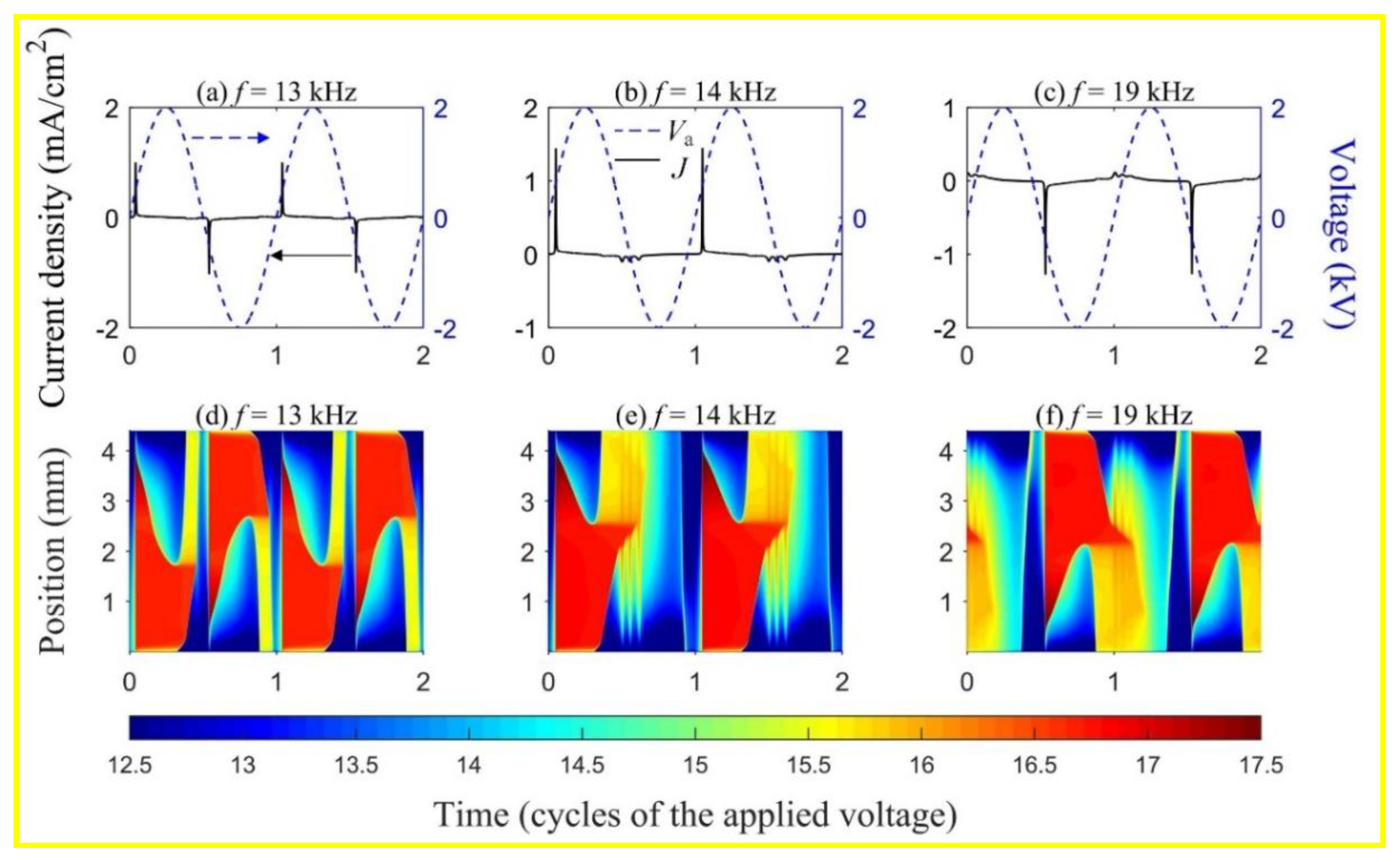
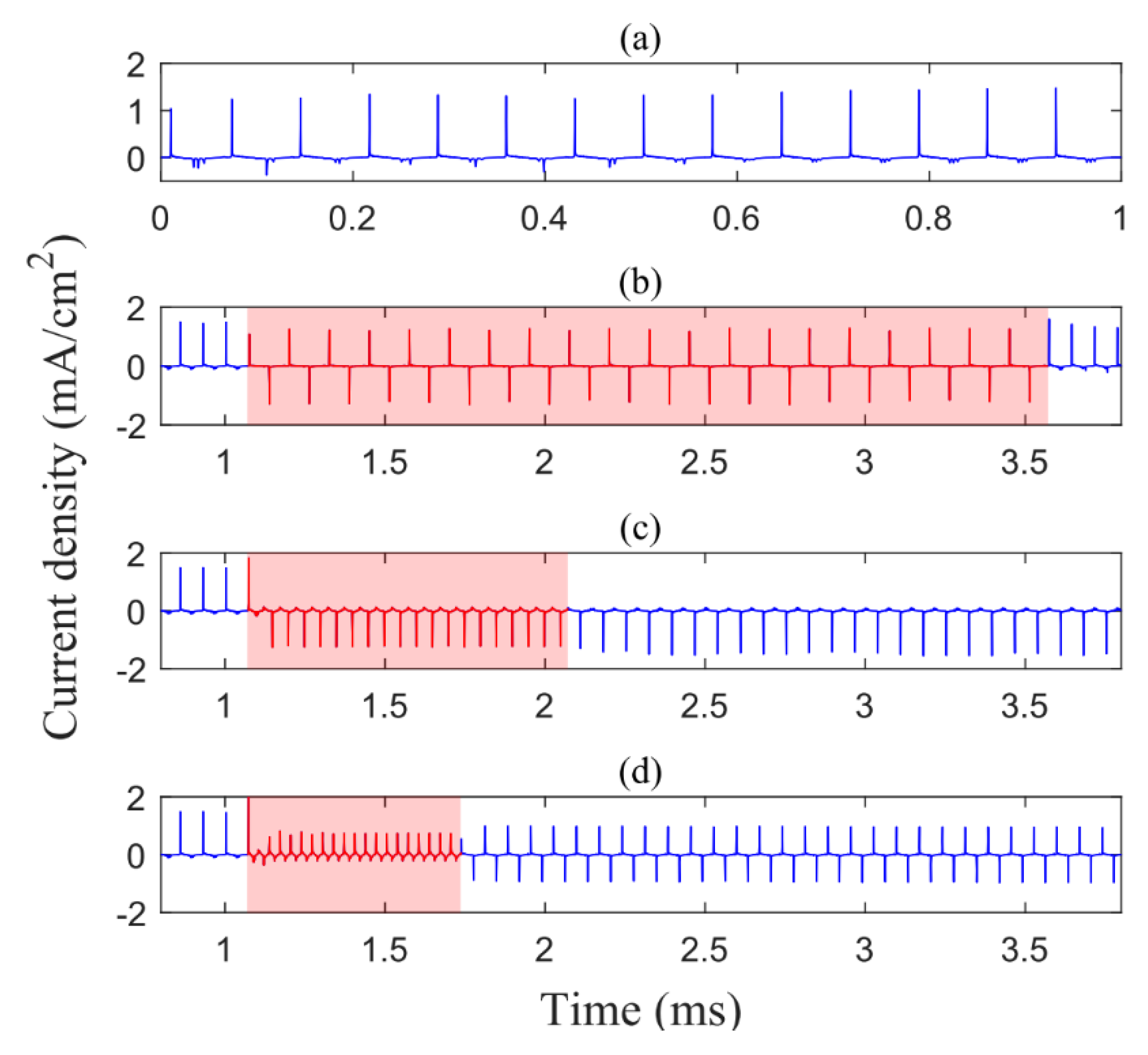
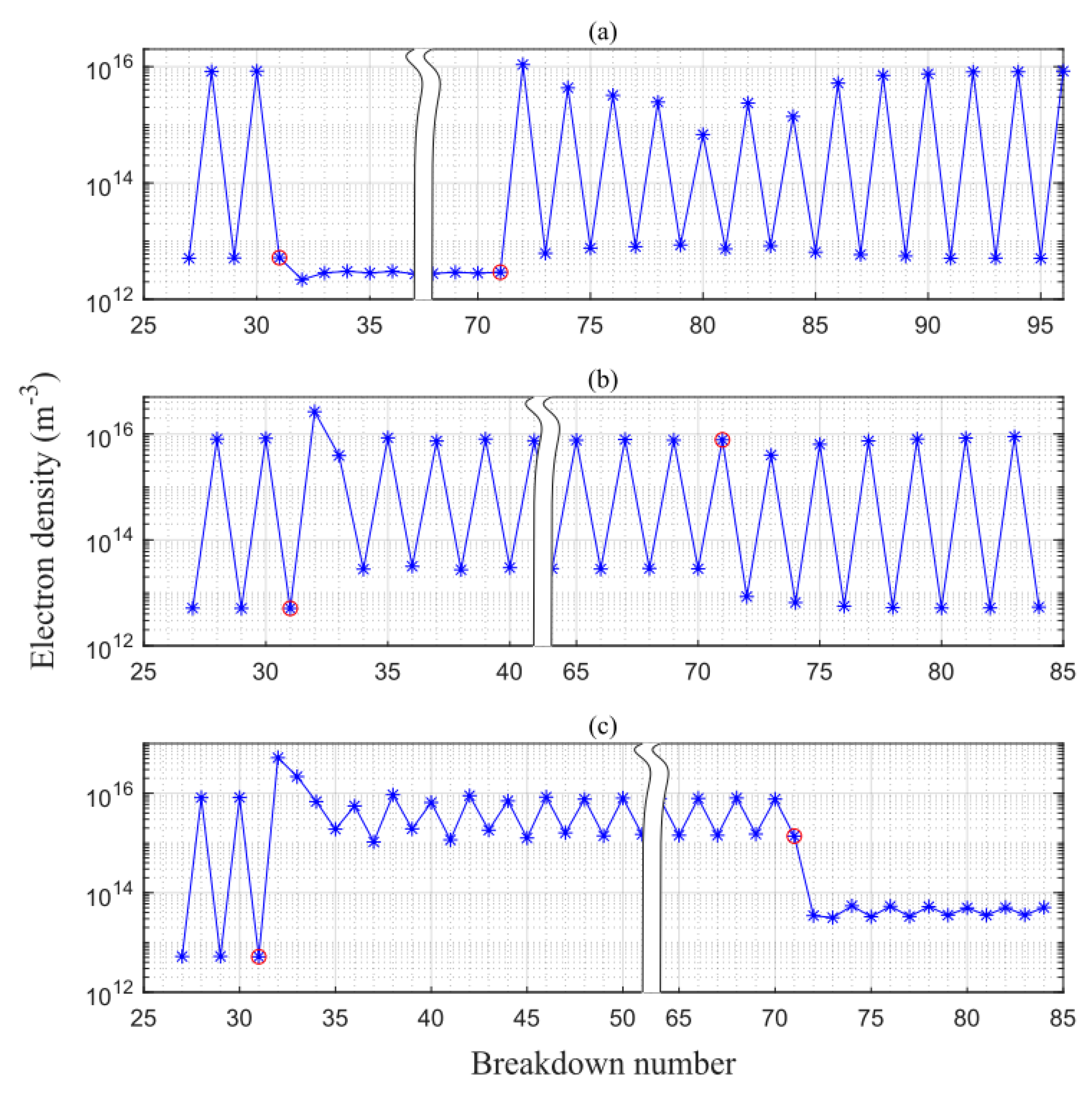
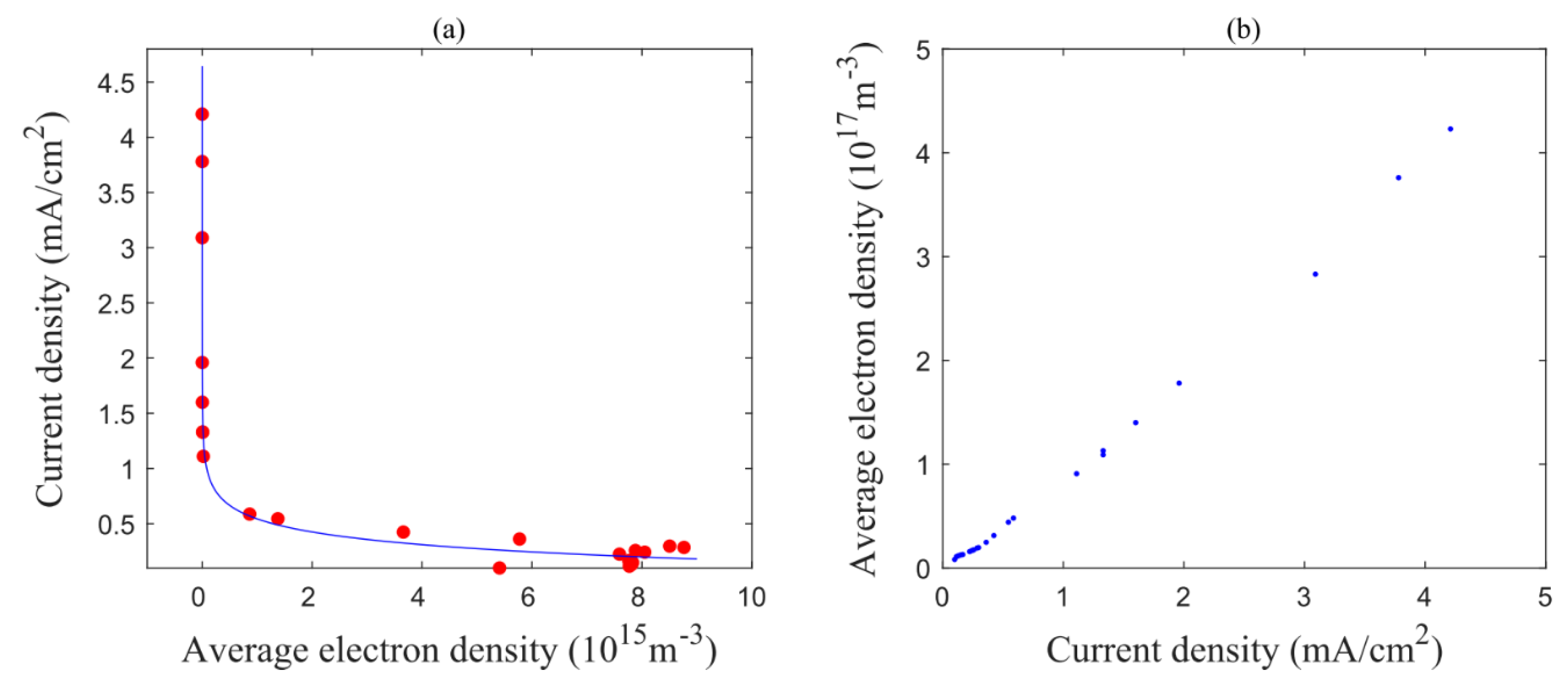
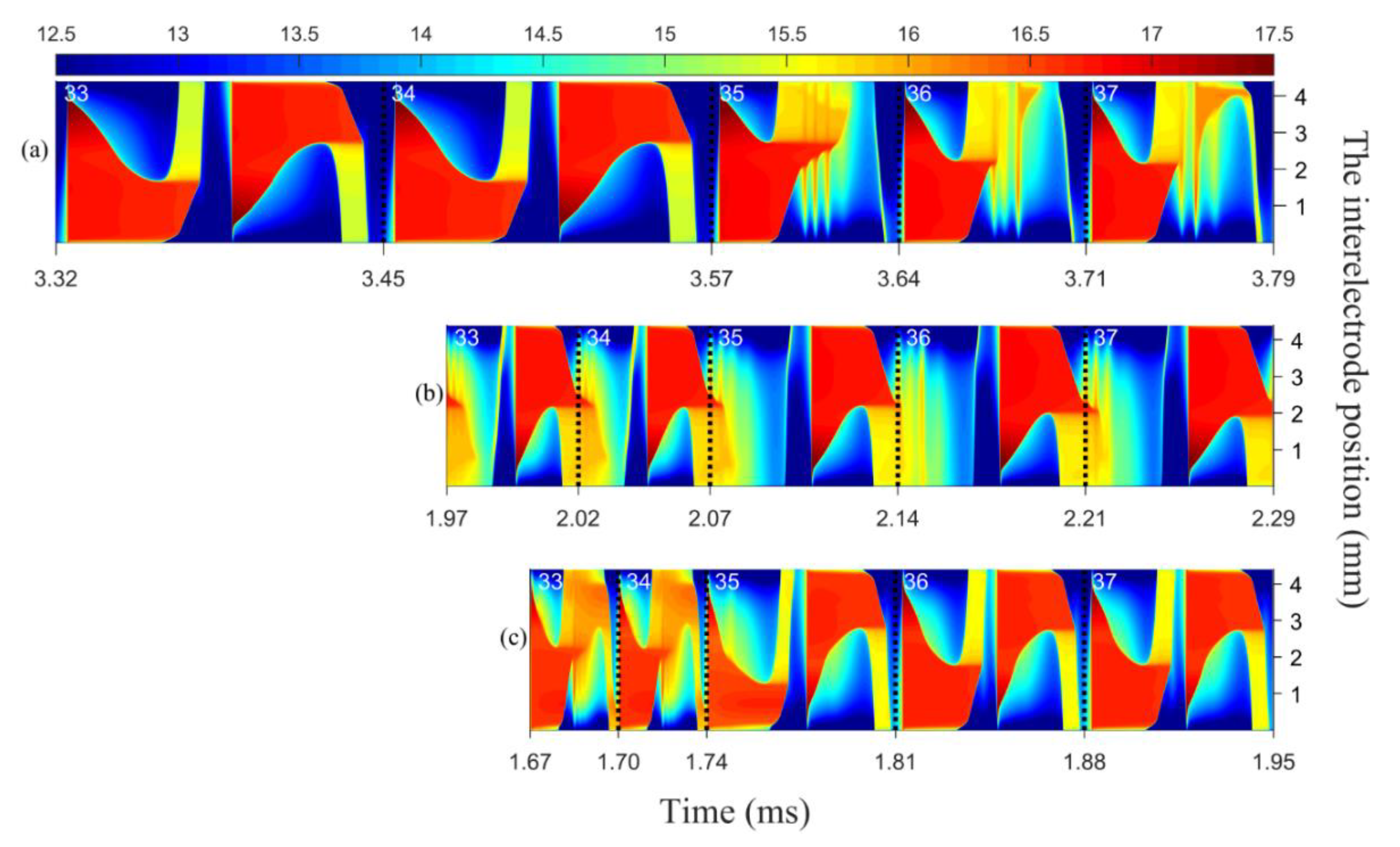
© 2020 by the authors. Licensee MDPI, Basel, Switzerland. This article is an open access article distributed under the terms and conditions of the Creative Commons Attribution (CC BY) license (http://creativecommons.org/licenses/by/4.0/).
Share and Cite
Luo, L.; Wang, Q.; Dai, D.; Zhang, Y.; Li, L. A Practical Method for Controlling the Asymmetric Mode of Atmospheric Dielectric Barrier Discharges. Appl. Sci. 2020, 10, 1341. https://doi.org/10.3390/app10041341
Luo L, Wang Q, Dai D, Zhang Y, Li L. A Practical Method for Controlling the Asymmetric Mode of Atmospheric Dielectric Barrier Discharges. Applied Sciences. 2020; 10(4):1341. https://doi.org/10.3390/app10041341
Chicago/Turabian StyleLuo, Ling, Qiao Wang, Dong Dai, Yuhui Zhang, and Licheng Li. 2020. "A Practical Method for Controlling the Asymmetric Mode of Atmospheric Dielectric Barrier Discharges" Applied Sciences 10, no. 4: 1341. https://doi.org/10.3390/app10041341
APA StyleLuo, L., Wang, Q., Dai, D., Zhang, Y., & Li, L. (2020). A Practical Method for Controlling the Asymmetric Mode of Atmospheric Dielectric Barrier Discharges. Applied Sciences, 10(4), 1341. https://doi.org/10.3390/app10041341





